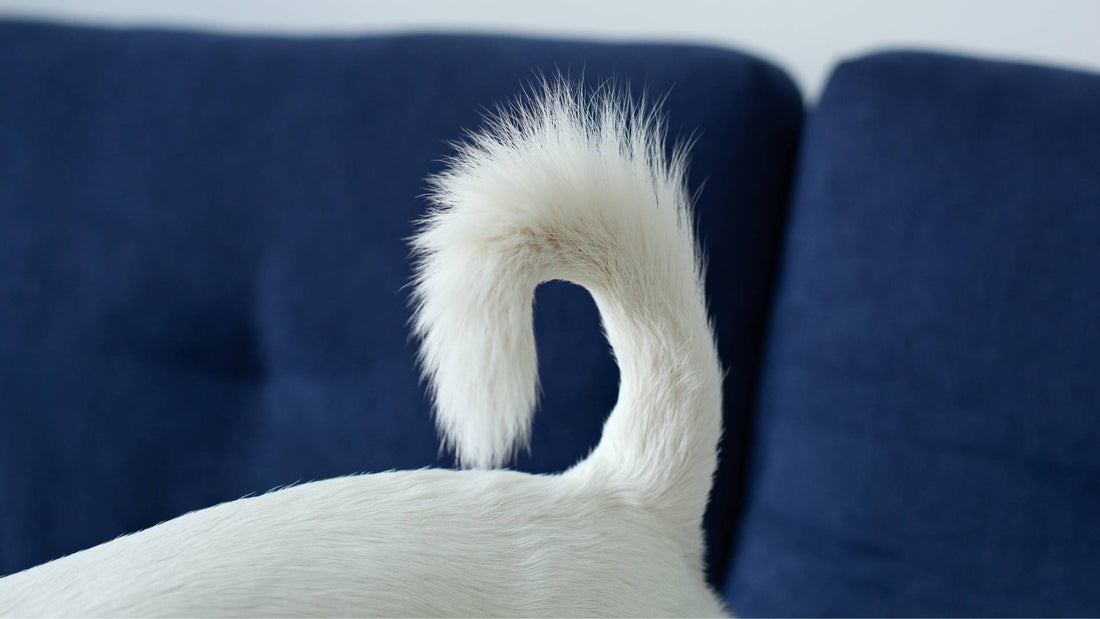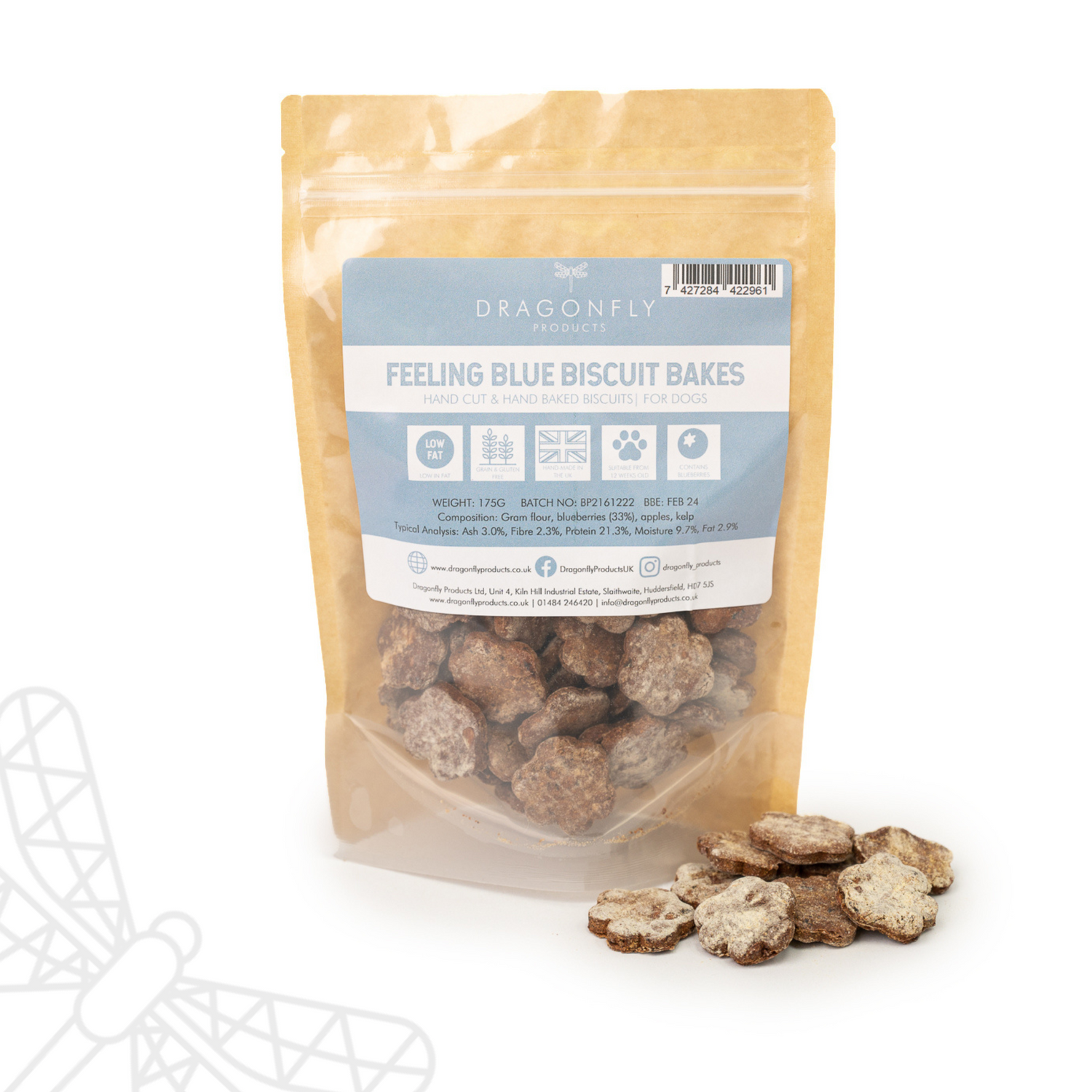
7 Reasons Why Dogs Bite Their Tails
Initially, it might seem like harmless fun when your dog starts chasing its own tail and most dogs exhibit this behaviour occasionally. However, when playing turns into persistent biting and gnawing, it's time to pay closer attention especially if, despite your efforts to deter the behaviour, your dog keeps returning to its tail for a nibble.
Table of Contents
- 1. Impacted Anal Glands
- 2. Allergies
- 3. Fleas, Ticks & Mites
- 4. Worms
- 5. Poor Hygiene
- 6. Injured Tailbone
- 7. Behavioural Issues
1. Impacted Anal Glands
The anal glands, also known as anal sacs, are located on both sides of your dog's anus. These glands are responsible for producing a pungent fluid used in territorial marking. Typically, when your dog poops, the pressure exerted pushes against the glands which releases this fluid, aiding in scent marking. However, if the fluid isn't adequately expressed, the anal glands may become full, clogged and impacted.
Impaction often occurs when a dog has soft stools (due to poor diet) that fail to empty the glands sufficiently. This leads to discomfort for the dog. Signs of impacted or full glands include biting and chewing at the tail area, as well as scooting the bottom along the floor and in some cases a distinct fishy odour can be noticed. In severe cases, the anal glands can become infected and form abscesses, further exacerbating the discomfort and requiring medical intervention to clear the infection
Solution:
Many professional groomers will be able to assess whether a dog’s anal glands are full and need manually expressing. Groomers are only allowed to externally express anal glands whereas a vet can internally express them (because this is classed as a medical procedure).
If the glands are full and just need expressing, this is a quick and painless job for experienced groomers. If the glands are impacted and potentially infected, veterinary intervention is required to alleviate the pressure and prescribe antibiotics to clear up the infection.
Issues with anal glands can be easily treated with dietary changes such as switching to a high quality dry or raw food, adding extra fibre or even including a supplement designed for anal gland health.
2. Allergies
Your dog's incessant tail-biting could be a result of allergies, triggering intense itching. Allergies can stem from various sources, including flea bites, dietary factors, or exposure to environmental allergens. Common food allergens include chicken and grain. Meanwhile, environmental triggers might include pollen from trees, grasses, and weeds. By identifying and addressing these allergens your dog’s discomfort can be alleviated. This includes elimination diets if the allergen is related to food or supplements to help with environmental allergies.
Solution
If a dog’s tail biting is down to an allergic reaction, it is important to speak to a canine nutritionist or holistic vet about identifying the source of the allergy. For food related allergies, this is often an elimination diet to pinpoint the ingredient that is causing the issue. Chicken is probably the most common allergen in commercial dog foods and often the cause of many issues.
Environmental allergies such as grass and pollen, can cause issues as the pollen count rises and the weather warms. Seasonal supplements are helpful in alleviating the itch as are avoiding areas with long grasses and rinsing your dog’s fur off after walks.
3. Fleas, Ticks & Mites
Fleas, ticks, and mites are common external parasites that can inflict considerable irritation and discomfort on dogs. When these parasites feed on the host's blood, they inject saliva into the skin to prevent clotting and facilitate feeding. For many dogs and cats, this saliva contains allergens that can trigger an allergic reaction.
When an allergic dog is bitten by fleas, their immune system reacts to the saliva, leading to an exaggerated response. This response manifests as severe itching, which can be intensely uncomfortable for the animal. Even a single flea bite can trigger a significant allergic reaction in susceptible pets. Similarly, ticks and mites can also cause itching and irritation through their bites, exacerbating the discomfort for allergic animals.
Solution:
There are many natural supplements on the market that can help to discourage unwanted external parasites, particularly during warmer months. If you suspect a flea infestation on your dog, check the tail area and back of the neck visually and with a flea comb.
Fleas can be treated with chemical treatments or with natural shampoos and a good old fashioned comb through with a flea comb which should be carried out every day for a week or so to ensure you have got rid of the issue. Washing bedding and treating areas where the dog sleeps is also vital to eradicating fleas.
Ticks should be removed manually and carefully using a specialist tick twisting tool and disposed of carefully (we love a good flush down the loo!).
4. Worms
Intestinal parasites such as worms can cause your dog’s anus to be irritated if the infestation is particularly high. Tapeworms can be transmitted by a flea bite or by the dog ingesting a flea, which is carrying tapeworm eggs. Roundworms are more common in puppies, and can be transmitted to humans by contact with contaminated poo.
Solution:
If you suspect your dog may have worms, carrying out a worm count will help you understand what is happening inside your dog’s system. If no worms are detected then it’s clear that this isn’t the cause of the tail biting issue. If the worm count comes back positive, treatment can be chemical from a veterinarian or natural in the form of grapefruit seed extract. Once treatment is complete, the tail biting behaviour should disappear immediately.
5. Poor Hygiene
Particularly with long haired dogs, when the hair around the anus becomes matted and accumulates dried poop, known as faecal mats, it can lead to skin irritation and infection. In extreme cases, these faecal mats can attract flies, potentially resulting in a maggot infestation on your dog. Maintaining proper cleanliness is crucial in preventing such discomfort and health risks for your dog.
Solution
If your dog is long haired, regular trips to the groomer will stop any faecal mats that may occur as the hygiene area can be kept clipped short to stop this occurring. As unpleasant as it may be, if your dog is biting its tail, check around the bottom for mats or dried on bits of poop that may need clearing away from the anus! Being a dog owner is not glamorous.
6. Injured Tailbone
A dog's tail is susceptible to a range of injuries, including fractures, dislocations, abrasions, and lacerations. Long-tailed breeds are particularly vulnerable to such injuries due to the increased length and exposure of their tails. When a tail sustains an injury, it can inflict significant pain on the dog.
Fractures occur when the tail bone is broken, often resulting from trauma such as being caught in a closing door or being stepped on. Dislocations involve the displacement of the tail bone from its normal position, causing discomfort and limited mobility. Abrasions and lacerations are surface wounds that can occur from various sources, such as sharp objects or rough play.
Solution:
If you suspect that your dog may have damaged its tail bone, a trip to the vet is the only solution. Injured tail bones can cause a lot of discomfort and should be addressed quickly to prevent further complications for your dog.
7. Behavioural Issues
Tail-biting behaviour in your dog could stem from underlying behaviour issues, particularly stress or anxiety. Dogs experiencing heightened levels of stress or anxiety may exhibit behaviours such as biting, gnawing, or excessive licking of their skin. Events such as the introduction of a new pet or person to the household, fireworks, or a household relocation can trigger significant stress in dogs, leading to tail-biting as a coping mechanism. Identifying and addressing the root causes of your dog's stress is essential in managing this behaviour effectively.
Solution
If your dog is tail biting due to anxiety and stress, treatment with a natural supplement to alleviate this may help, or your dog may be referred to an animal behaviourist. An animal behaviourist can observe your dog and make recommendations, which will help with bouts of stress and/or anxiety.
In conclusion, understanding why dogs bite their tails is essential for providing appropriate care and addressing this behaviour effectively. By identifying the underlying cause, whether it be medical, environmental, or behavioural, dog owners can take proactive steps to alleviate their dog's discomfort and promote a healthier, happier life. With patience, consistency, and the guidance of dog professionals and behaviour experts, tail-biting can be managed and resolved, allowing dogs to thrive and enjoy their lives to the fullest.
In conclusion, understanding why dogs bite their tails is essential for providing appropriate care and addressing this behaviour effectively. By identifying the underlying cause, whether it be medical, environmental, or behavioural, dog owners can take proactive steps to alleviate their dog's discomfort and promote a healthier, happier life. With patience, consistency, and the guidance of dog professionals and behaviour experts, tail-biting can be managed and resolved, allowing dogs to thrive and enjoy their lives to the fullest.
For any further help and advice please contact us on 01484 246420 and why not join our social media channels and online community on Instagram, Facebook or YouTube.
With Wags and Woofs,
Laura, Dolly & Reggie








